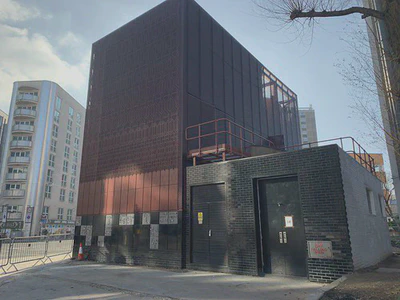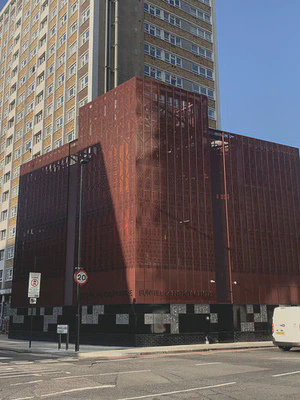For the last few years the view from my office window has included the construction site for the Bunhill 2 Energy Centre, part of the Bunhill heat network. The barricades have finally come down to reveal the nearly-finished item.
This second phase of the project extracts waste heat from an electricity sub-station and the Northern Line of London Underground via a 1MW heat exchanger. The building in the photos is on the site of the disused Central Street station, closed in 1922, and is directly above the tube tunnel.

The lower height part of the building in the photo above is a skin around the remains of the original 1901 structure, now housing an existing sub-station.

According to the architects Cullinan Studio:
This phase, which connects to the original network completed in November 2012, brings in low carbon sources of heat to the residents of five communally heated residential blocks (454 dwellings). It is also seeking to supply an additional three new communally heated residential developments (a further 215 homes), a school, a sheltered housing block, a community centre and a nursery.
The engineering design was carried out by the Danish firm Ramboll:
The Northern Line, the oldest deep level metro line in the world, will heat 21st century homes, offices and leisure centres. The project will be a European first of its kind, extending what is possible when using waste energy to make for a more liveable, more sustainable society. The proposed low-carbon heat source was a London Underground ventilation shaft, located on City Road, where 18-28 degrees Celsius air is exhausted to the atmosphere from a long abandoned tube station (City Road, between Old Street and Angel), now part of the Northern Line tunnel ventilation system. Ramboll’s feasibility study confirmed that this source of waste heat could be exploited by heat pumps, which would capture the waste heat and upgrade it to approximately 80 degrees Celsius Another design innovation was to incorporate two smaller gas-fired CHP engines which, as well as providing heat, also supply electricity directly to the heat pump when the power from the grid is most expensive, helping reduce the cost of the heat
(Photos CC-BY-ND Julian Elve 2020 also on Flickr here and here)